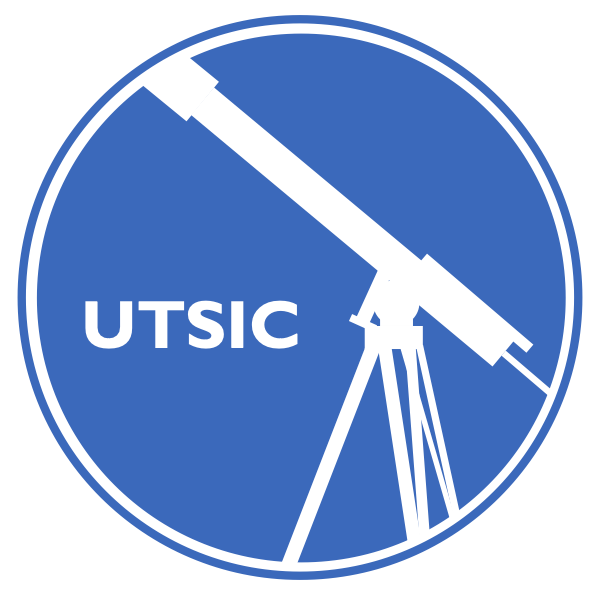2019.ast.231.1 – A rectangular wooden box with part of one side open, and a glass top. About two centimeters under the glass top there is an opaque plate with a piece of paper, folded, lying on top of it. Underneath this, and accessible through the open section of the side is another glass plate slanted at a diagonal angle in the box, and a light bulb in a ceramic base that is fixed to one end of the table so the light bulb is held horizontally. with a long brown coiled cable with textile insulation. At the end of this is a two-pronged plug.
2019.ast.231.2 – With the object, there is a 1939 photographic plate depicting a globular cluster inside a paper envelope.
Accession Number: 2019.ast.231.1-2
Alternative Name:
Primary Materials: Wood, Glass.
On a sticker affixed to the top glass panel: “LIGHT TABLE USED BY H.S.H.”
On the paper envelope: “NGC 6205
4817
9490.597
1939 Aug. 14 EST
21 05 – 21 41
(clouds)
2 14 W”
On a label with the object: “Light Table
Used by Helen Sawyer Hogg with one of her photographic plates from 1939 of Messier 13 (M13, NGC 6205), also called the “Great Globular Cluster in Hercules”, one of the most prominent and best known globulars of the Northern celestial hemisphere.”
Box: Height = 13, Width = 15.2, Length = 28; Plate: Height = 0.2, Width = 9.2, Length = 12.
The easy viewing of glass plate photographs and images. The lightbulb and translucent glass surface provides a back-lit surface for the viewing of two or three 3″ slides. The clear glass is removable and may provide separation from the hot surface next to the lightbulb.
The object was once on display; the plate with the object was used to demonstrate the function of the light table.
Very Good: The box is in good condition. The glass plates are intact, although the top section has some residue in the centre and the affixed sticker. The wooden surfaces are in very good condition. The piece of paper on top of the translucent glass is yellowed, particularly around the edges.
Associated Instruments:
Manufacturer: Unknown
Date of Manufacture: c. 1920s-1940s
This item was used by University of Toronto astronomer Dr. Helen Sawyer Hogg, possibly at the David Dunlap Observatory in Richmond Hill, from the mid-1930s onwards. It was also used in the early 1960s by Hogg’s research student, Christine Clement. The table was kept at, or moved to, the David Dunlap Observatory, where it stayed until 2009. Upon the sale of the Observatory, it was moved to the University of Toronto’s Department of Astronomy & Astrophysics at the St George Campus. In 2017 it was moved to a new storage location in McLennan Physical Laboratories.
Additional Information and References:
This table was used by University of Toronto astronomy professor Helen Sawyer Hogg for the identification and measurement of variable stars. Hogg moved to the David Dunlap Observatory in Richmond Hill when her husband received a job there in 1935. She continued her work, including taking the included 1939 plate of the globular cluster M13, while also traveling for her research. She took on teaching duties at the university during WWII and later advanced to full professor in astronomy at the Department of Astronomy at the University of Toronto.
Professor of Astronomy Christine Clement remembers being trained to use this table by Hogg as part of research conducted for Hogg in the summer of 1963, just prior to her Master’s degree. Clement recalls:
“I was given a little eye piece, and I had to put it down on the plate and examine the images. The object was to estimate the brightness of the variable stars, but to do that, you have to have standards to compare them with. So someone had already set up a sequence of standards: stars A, B, C, D, E, F, G, which were labelled on an ID chart. The chart is a print that looks exactly like the plate, i.e. a negative print. Having a negative print is convenient because you can write on it and label the positions of the stars of interest, both the standards and the variables.”
Also in 1963, Hogg acquired a Cuffey iris astrophotometer, for the measurement and analysis of variable stars, which Clement also used. The astrophotometer is at the Canada Science and Technology Museum, accession number 2008.0184.001.
Clement remembers the light table sometimes having an advantage over more complex technologies, such as an iris photometer in that it enabled the examination of individual stars on ‘messy’ plates stars were close together, as in a globular cluster, shown in the accompanying plate: “…because if the field is too crowded the iris diaphragm picks up other stars in the vicinity and makes a crowded star appear brighter than it really is. And so good old Helen and her eye and brain were smarter than that machine. The eyepiece was still advantageous in situations like this.”
However, by the late 1980s, iris photometers were superseded by scanning machines which digitized the images and used image processing software to make more precise measurements of stars in crowded fields. And by the 1990s, photographic plates were replaced by CCD detectors which produced digital images.
The grey background of the plate shows the brightness of the sky in the location where the plate was taken. As light pollution in Richmond Hill, where the David Dunlap Observatory is located, increased, the greyness of the sky in plates like this one became darker, making discerning stars more difficult.
Christine Clement was interviewed on February 28, 2021. Thanks to Professor Clement for her assistance with this text.
